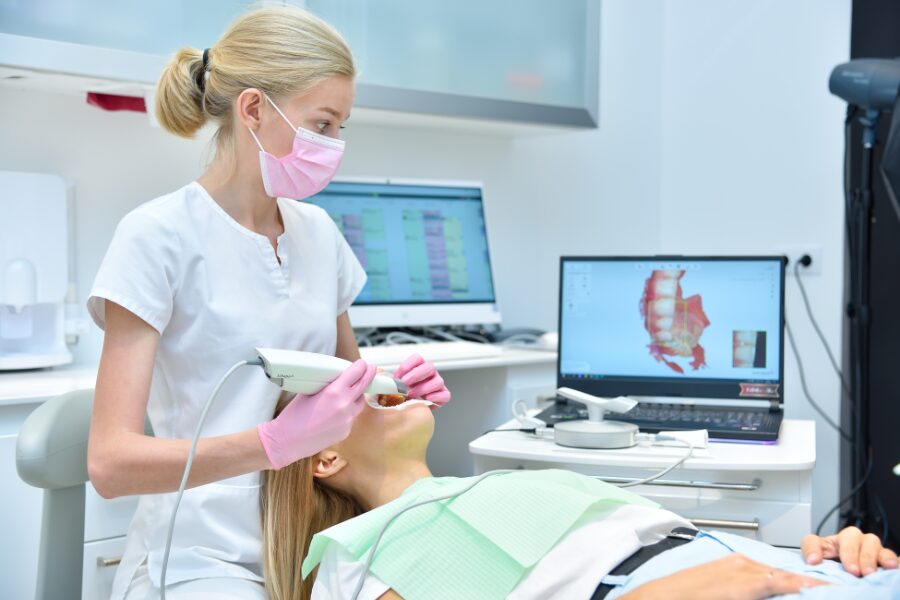Dental Lab Products Every Dentist Should Use
Dental professionals are always on the lookout for new, innovative dental lab products, tools and technologies that can enhance their practice and deliver exceptional patient care.
This blog post explores the crucial dental lab products that every dentist and prosthodontist should consider incorporating into their workflow.

2024 Dental Lab Products: What’s New & Improved
Dental Impressions with Accuracy: The Intraoral Scanner
Why Choose Digital Scanning?
Gone are the days of cumbersome alginate impressions that often result in retakes and discomfort. The advent of intraoral scanners has revolutionized this aspect of dentistry:
- Time Efficiency: Digital impressions are significantly faster than traditional methods.
- Improved Accuracy: High-resolution images reduce the potential for errors.
- Better Patient Experience: Less invasive and more comfortable for patients.
Intraoral scanners, such as the 3Shape TRIOS and iTero Element, provide dentists with real-time, high-quality images of a patient’s dental structure, drastically improving diagnosis and treatment planning.
Sterilization: Autoclaves and Sterilizers
Ensuring that all dental instruments are sterilized is non-negotiable in a clinical setting to prevent infection and maintain a sterile environment.
Advantages of Modern Sterilizers
Investing in a quality autoclave, such as those offered by Midmark or Tuttnauer, provides:
- Effective Sterilization: Using steam under pressure to kill all microbes.
- Speed: Modern autoclaves can complete a cycle in just a few minutes.
- Ease of Use: Automated cycles and digital interfaces enhance usability.
Periapical Radiographs: A Dentist’s Eye Beneath the Surface
Periapical radiographs, also known as periapical x-rays, are a vital tool in dentistry that allows dentists to see beneath the surface of the tooth and surrounding bone. Unlike a visual examination, which can only assess the crown of the tooth, periapical radiographs provide a comprehensive view of the entire tooth structure, including the roots and jawbone. This information is crucial for diagnosing a variety of dental problems, such as:
- Tooth decay: Periapical radiographs can reveal cavities, even between teeth where they may not be visible during a routine exam.
- Gum disease: By examining the bone levels around the teeth, periapical radiographs can help dentists assess the severity of gum disease.
- Bone loss: Periapical radiographs can detect bone loss due to gum disease, trauma, or other factors.
- Root fractures: Cracks or breaks in the root of a tooth can be difficult to diagnose without periapical radiographs.
In addition to diagnosing dental problems, periapical radiographs are also used to monitor the progress of dental treatments, such as root canals and dental implants. By taking periapical radiographs at different stages of treatment, dentists can ensure that the treatment is progressing as planned and identify any potential complications.
Silver Diamine Fluoride: A New Tool in the Management of Tooth Decay and Sensitivity
In addition to the essential dental lab products mentioned above, progressive dental practices should also consider incorporating silver diamine fluoride (SDF) into their treatment options.
SDF is a topical solution gaining traction in dentistry for its effectiveness in managing tooth decay and sensitivity. Here’s why it deserves a spot in your dental armamentarium:
- Combating Cavities: SDF tackles tooth decay by combining two powerful ingredients:
- Silver: acts as a bactericide, killing cavity-causing bacteria.
- Fluoride: promotes remineralization, strengthening weakened tooth enamel and halting the decay process.
- Treating Sensitivity: SDF can also be used to address tooth sensitivity by desensitizing exposed dentin, the layer beneath the enamel.
- Minimally Invasive: Unlike traditional cavity fillings that require drilling, SDF treatment is a painless, non-invasive procedure involving a topical application to the affected tooth.
- Patient-Friendly: The quick and painless application makes SDF a particularly good option for children or patients with dental anxiety.
- Cost-Effective: Compared to traditional fillings, SDF offers a more affordable approach to managing cavities, especially in early stages.
While SDF boasts numerous advantages, it’s crucial to be aware of a few limitations:
- Staining: A potential downside of SDF is that it can stain the treated tooth brown or black. This is typically less of a concern for children’s primary teeth but may be a consideration for permanent teeth in cosmetically sensitive areas.
- Limited Applications: SDF may not be suitable for all cavities, particularly deep or advanced ones. Your dentist will assess the severity of the decay to determine if SDF is the most appropriate course of action.
To stay at the forefront of dental technology, incorporating these essential lab tools is a wise strategy for any dental practitioner, whether seasoned or newly minted.
Whether upgrading an existing practice or setting up a new one, these top dental lab products are indispensable tools in the arsenal of modern dentistry.



Leave a Reply
Want to join the discussion?Feel free to contribute!